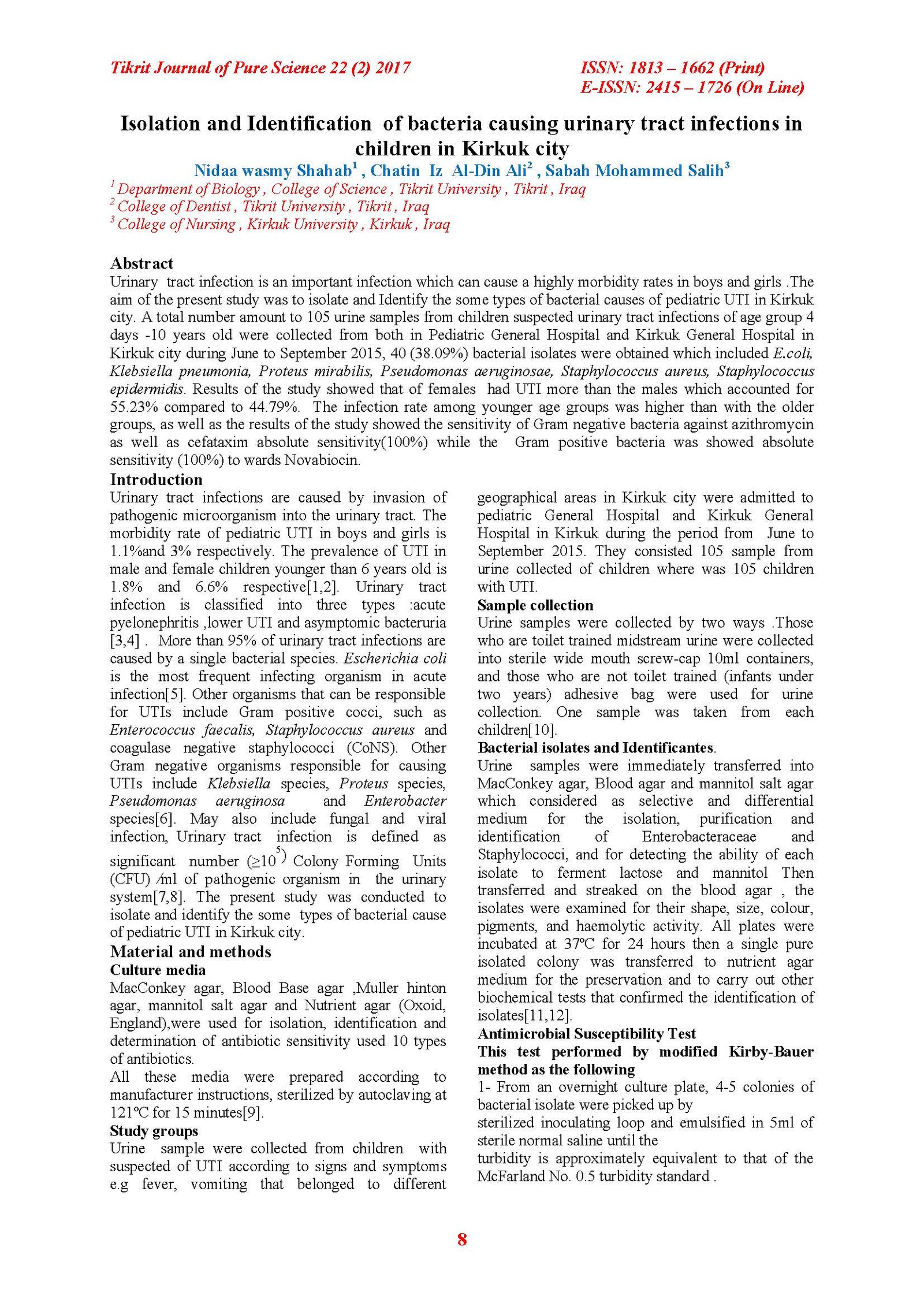Isolation and Identification of bacteria causing urinary tract infections in children in Kirkuk city
Main Article Content
Abstract
Urinary tract infection is an important infection which can cause a highly morbidity rates in boys and girls .The aim of the present study was to isolate and Identify the some types of bacterial causes of pediatric UTI in Kirkuk city. A total number amount to 105 urine samples from children suspected urinary tract infections of age group 4 days -10 years old were collected from both in Pediatric General Hospital and Kirkuk General Hospital in Kirkuk city during June to September 2015, 40 (38.09%) bacterial isolates were obtained which included E.coli, Klebsiella pneumonia, Proteus mirabilis, Pseudomonas aeruginosae, Staphylococcus aureus, Staphylococcus epidermidis. Results of the study showed that of females had UTI more than the males which accounted for 55.23% compared to 44.79%. The infection rate among younger age groups was higher than with the older groups, as well as the results of the study showed the sensitivity of Gram negative bacteria against azithromycin as well as cefataxim absolute sensitivity(100%) while the Gram positive bacteria was showed absolute sensitivity (100%) to wards Novabiocin.
Article Details

This work is licensed under a Creative Commons Attribution 4.0 International License.
Tikrit Journal of Pure Science is licensed under the Creative Commons Attribution 4.0 International License, which allows users to copy, create extracts, abstracts, and new works from the article, alter and revise the article, and make commercial use of the article (including reuse and/or resale of the article by commercial entities), provided the user gives appropriate credit (with a link to the formal publication through the relevant DOI), provides a link to the license, indicates if changes were made, and the licensor is not represented as endorsing the use made of the work. The authors hold the copyright for their published work on the Tikrit J. Pure Sci. website, while Tikrit J. Pure Sci. is responsible for appreciate citation of their work, which is released under CC-BY-4.0, enabling the unrestricted use, distribution, and reproduction of an article in any medium, provided that the original work is properly cited.
References
1. Hansson S, Jodal U(2004). Urinary tract infection. In: Avner ED, Harman WE, Niavdet P, editors. Pediatric nephrology. 5th ed. Philadelphia: Lippincott Williams & Wilkins:1007-25.
2. Elder JS (2011). Urinary tract infection. In: Kliegman RM, Stanton BF,St. Geme JW, Schor NF, Behrman RE, editors, Nelson textbook ofpediatrics. 19th ed. Philadelphia: Saunders:1829-38.
3. Riccabona M(2003). Urinary tract infections in children. Curr Opin Urol;13:59-62.
4. Buonsenso D, Cataldi L(2012). Urinary tract infections in children: a review.Minerva Pediatr :64:145-57.
5- Baraboutis H, Tsagalou N, Lepinski A, et al(2011). Primary Staphylococcus aureus urinary tract infection:the role of undetected hematogenous seeding of the urinary tract. Eur J Clinical Microbiol Infect ;12: 1095-1101.
6- Hryniewicz K, Szczypa K, Sulikowska A, Jankowski K, Betlejewska K, Hryniewicz W(2001). Antibiotic susceptibility of bacterial strains isolated from urinary tract infections in Poland. J Antimicrob Chemother ; 47:773—780.
7- Schnarr J, Smaill F(2008). Asymptomatic bacteriuria and symptomatic urinary tract infections in pregnancy. Eur J Clin Invest ; 38 (2): 50–57.
8- Agarwal P J(2012). Symptom-based diagnosis of urinary tract infection in women: are we over-prescribing antibiotics?. Int J Clin Pract ; 6:493–498.
9. Morello, J.A.; H.E. Mizer; and P.A. Granato (2006). Laboratory Manual and Work book in Microbiology Applications to Patient Care. 18th.ed. The McGraw-Hill Companies , Inc.,New York.95-99.
10-Ghanghro,A.B.,and Laghari, A.H.(2010). Urinary Tract Infection as a predictor of childhood malnutrition in southern Sindh ,Pakistan Journal of Nutrition,9:819-821.
11-Atlas, M.R. (2005). Handbook of media for Invironmental microbiology.2nd ed. Taylor& Francis publisher. New York 33-43.
12- Susan R. Heimer and Harry L.T. Mobley (2001). Intraction of protease mirabilis urease Apoenzyme and Accessory proteins Identified with yeast two Hybrid Technology” . J. Bacteriol, 183 .1423-1433 .
13. Vandepitte, J.; J. Verhaegen; K. Engbaek; P. Rohner; P. Piot; and C.C. Heuck. 2003.Basic Laboratory Procedures in Clinical Bacteriology. 2nd.ed. World Health Organization, Geneva.
14- Cynthia C(2001).General Description of Urinary tract infection” NidusInformation services , Inc. 41 East 11 the street , 11 the floor .
15.Nasciment,G.G.F.;Locatelli,J.Freitas,p.c.andsilva,G.L.(2000).Antibacterial activity of plant extracts and
phytochemicals on antibiotic – resistant bacteria, Braz. J. Microbiol., 31(4).
16-Sonavane, A.; Mathur, M.; Turbadkar, D. and Baradkar v. (2008). Antimicrobial susceptibility pattern in urinary bacterial isolates. Bombay Hospital Journal, 50(2):240-244.
17-Al-Geborry, G.M. (2009). Etiology of bacterial pathogens caused urinary tract infections in children of AL-Nasseria city .Al-Nassiriya Technical Institute.
18-Rupinder, C.S.; Mc Neeley D.F., and Mehta, M.(2012). Prevalence of urinary tract infections in children and their sensitivity to various antibiotics . J. Acad. Indus.Res.1(4)161:2278-5213.
19-Herr, S.M.; Wald, E.R., Pitetti, R.D., and Choi, S.S. (2004). Enhanced urinalysis improves identification of febrile infants ages 60 days and younger at low risk serious bacterial illness. pediatrics. 108.866-879.
20-Keren, R.; Carpenter, M.A., and Hoberman A., etal. (2008). Rationale and design issues of the randomized intervention for children with vesicoureteral Reflux (RIVUR) study. Pediatrics.; 122, 240-250.
21-Inabo, H.I. and Obanib, H.B. (2006). Antimicrobial susceptibility of urinary tract clinical isolates to commonly used antibiotic. African Journal of Biotechnology,(5):487-489.
22- Naylor GH(1998).A16 month analysis of Urinary tract infection in children” Journalof Medical Microbiology, 17 (1). 31-36 .
23- Forbes, B.A; Sahm, D.F. and Weissfeld, A.S., Bailey and Scotts (1998). Diagnostic Microbiology, 10 the ed Mosby.
24- Najah A. Mohammed, Abdalaa L. Jiad (2004).A bacteriological study of urinary tract infection in Baquba city” , J. Technology, 7 ( 4) .
